John Wolff's Web Museum
Early Electronic Calculators - Portable
This page shows a selection of interesting portable calculators
from a variety of manufacturers, arranged more or less in
chronological order. Please refer to the separate
brands listings for machines from
Canon, Casio, Sanyo, Sharp, and others.
Click on the photos for larger illustrations, or follow the
links for further details.
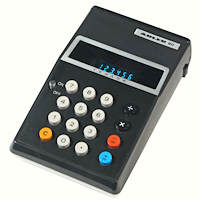 Adler Model EC-60, S/N 65050387
Adler Model EC-60, S/N 65050387
Functions: ASMD
Technology: MOS-LSI (Omron HD 32163P)
Display: 6 digits, vacuum fluorescent tube
Dimensions: 100W x 157D x 43H, weight 360g including batteries.
Manufactured: Made in Japan for TA Vertriebs GmbH, Nürnberg,
Germany, 1973
The Adler EC-60 is a very basic four-function portable calculator
from 1973. It was supplied with a soft slip case with a carrying strap,
but is much too large to be called a "pocket" calculator.
The EC-60 uses a single-chip Hitachi HD-32163P processor (made by
Omron) and a single-ended 6-digit fluorescent display tube from ISE.
The display digits are only about 4.5mm high. Power consumption is
about 120mA (720mW) from four AA batteries or an external AC adapter.
The batteries and input socket are held in a removable carrier
which clips in to the end of the case, suggesting that an alternative
module with rechargeable NiCad batteries may have been available.
EC-60 rear view with battery carrier (23kb).
EC-60 circuit board (32kb).
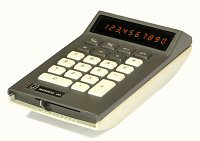 Monroe Model 40, S/N F048054
Monroe Model 40, S/N F048054
Functions: ASMD, percent
Technology: MOS-LSI, single chip (GI 175A)
Display: 10 digits, 7-segment neon (Panaplex II)
Dimensions: 85W x 150D x 45H, weight 365g.
Manufactured: Monroe Division, Litton Business Systems, USA, 1974
The Monroe Calculating Machine
Company first ventured into electronic calculators in the mid-1960s
by selling re-badged desktop machines built by
Canon in Japan and
Compucorp in the USA. This
portable Model 40 from 1974 appears to have been designed in the
USA by Monroe themselves.
The calculator operates in the traditional adding-machine fashion
for addition and subtraction, with separate Total and Sub-total keys.
The display shows the last value entered, rather than the running
total. Multiplication and division operate algebraically, with a common
Equals key and an independent result register. Separate +/= and -/=
keys are provided to add the results of multiplications or divisions
into the addition register. This arrangement has the peculiar effect
that a multiplication or division can be carried out in the middle of
a string of additions without upsetting the accumulated total.
The calculator uses a General Instruments 175A processor and a
Burroughs Panaplex II gas-discharge display, and draws about 900mW
from 4 disposable AA batteries or a rechargeable NiCad pack. The
sliding power switch at the front of the machine also serves as the
decimal selector, with a choice of 0 to 6 fixed places, adding
machine mode (with an assumed decimal point), or full floating point
operation.
The distinctive case for the Model 40 was designed by Myron Beitler
and Douglas Graham of Monroe/Litton in 1973 (US design patent D236483).
Monroe 40 internals (30kb).
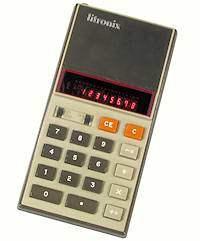 Litronix LED calculator, Model 1100, S/N 337064
Litronix LED calculator, Model 1100, S/N 337064
Functions: ASMD, fixed decimal point
Technology: MOS-LSI (single chip)
Display: 8 digits, miniature LED modules
Dimensions: 75W x 150D x 20H, weight 180g.
Manufactured: Assembled in Malaysia by Litronix Inc,
Cupertino, CA, 1974
Litronix Inc was established in 1970 to manufacture opto-electronic
components based on the new light-emitting diodes (LEDs). The company
established a manufacturing plant in Malaysia, and was a major
supplier of LED components and displays until it was taken over by
Siemens in the 1980s. A range of calculators and LED watches was
produced under the Litronix brand to showcase their own displays.
The Model 1100 is a revised version of Litronix's first "Checkmate"
calculator, which was part of the 1970s craze for "check-book
balancing" applications. Like its predecessor, the Model 1100 is
a very basic four-function calculator with a fixed-decimal system.
Inputs and results are restricted to either 6.2 or 4.4 format
(ie, nnnnnn.dd or nnnn.dddd), according to the setting of the
Decimals switch. However, the calculator always operates internally
to 12 figures. If the result exceeds the capacity of the selected
format, the calculator shows the least significant digits and lights
an overflow indicator. The result can then be divided manually by
1000 (or other convenient factor) to retrieve the higher digits.
If the result exceeds 12 figures the display shows all zeros, and
the caclulator must be cleared in order to continue.
The
circuit board carries a 40-pin processor chip identified only by
a hand-written paper label. (There are no markings under the label).
There are two 16-pin chips adjacent to the keyboard and display, also
unidentified. The LED display uses three miniature 3-digit 7-segment
modules, with a single overflow LED at the left-hand side. The
display modules have built-in magnifying lenses, and have a fairly
limited viewing angle. The keyboard is a "click" module from Texas
Instruments, with two small slider switches for power and decimal
selection. The main circuit board is hand-soldered, and the calculator
is assembled with clips, glue, and heat-staked plastic pins.
The calculator draws 40 to 60mA (270mW max) from three AA
batteries. A small encapsulated power supply (top, in PCB view)
provides the additional voltages needed for the MOS processor.
Litronix 1100 circuit board.
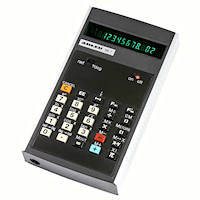 Adler scientific calculator, Model 108T, S/N 68.687.704
Adler scientific calculator, Model 108T, S/N 68.687.704
Functions: ASMD, scientific functions
Technology: MOS-LSI (single chip)
Display: 8+2 digits, 12-digit vacuum fluorescent module
Dimensions: 85W x 147D x 25H, weight 320g.
Manufactured: Made in Japan for TA Vertriebs GmbH, Nürnberg,
Germany, 1975
The Adler 108T is a portable "scientific" calculator from 1975. It
provides trig functions and their inverses in degrees or radians,
powers and roots, natural and base-10 logarithms, and one memory register
with direct memory artithmetic. The calculator uses algebraic entry with
two levels of parentheses, but all of the scientific and memory functions
require the use of an "F-key" prefix. An "inverse F-key" is provided for
the trig functions. Results greater than 8 digits or less than 1 are
displayed in scientific notation.
The processor is a single-chip Rockwell LA4802PA dated October 1975,
on a circuit board labelled "GICO Japan". The display uses a 12-digit
fluorescent panel (Itron FG125A2) to show results in "8+2" format, with
the remaining two positions reserved for signs and memory/error indicators.
Results from the scientific functions are produced quickly (well under a
second), but are only shown to six figures. The circuitry draws 50-60mA
(about 300-350mW) from four disposable AA batteries or an external AC
adaptor.
The calculator has a black right-angled plastic casing with a
wrap-around aluminium sleeve covering the sides and the back. The sleeve
slides upwards to reveal the nameplate and to open the battery compartment.
The external design is based on an earlier range of calculators developed
in 1972 by Rockwell and the Bell Punch
Company and sold under the Triumph, Adler, and Anita brands. Further
details of the connections between these companies can be found on
Nigel Tout's
Anita Calculators web site.
The mid-1970s Adler calculators appear to have been made in Japan
from a British design for sale by a German company - but both the British
and German companies were owned by Americans! Triumph-Adler was owned by
Litton Industries (Monroe) from 1968, and Sumlock (Anita) was owned by
Rockwell from 1973.
Adler 108T internal view.
Adler 108T circuit board detail.
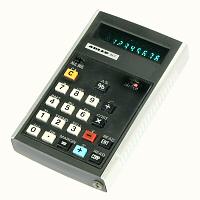 Adler Financial Calculator, Model 84F, S/N 68.828.401
Adler Financial Calculator, Model 84F, S/N 68.828.401
Functions: ASMD, percent, financial calculations
Technology: MOS-LSI (Rockwell A4561PB)
Display: 8 digits, vacuum fluorescent module
Dimensions: 75W x 120D x 20H, weight 200g.
Manufactured: Made in Japan for TA Vertriebs GmbH, Nürnberg,
Germany, 1975
The Adler 84F is a compact pocket calculator for business and
financial applications. In Algebraic mode it performs only ASMD and
percentage calculations, with all results rounded to 2 decimal places.
In Business mode it performs pre-programmed financial calculations
involving prices, payments, and interest, with assistance from the
Enter and Compute keys.
The calculator is similar in appearance and construction to the
scientific model above, except that the reduced dimensions required the
use of smaller AAA batteries. The processor is a single-chip Rockwell
A4561PB dated April 1975, on a circuit board labelled "GICO Japan". The
display is a 9-digit vacuum fluorescent panel, with the leftmost digit
reserved for minus and error indicators. Power consumption is about 400mW.
Adler calculator in slip case.
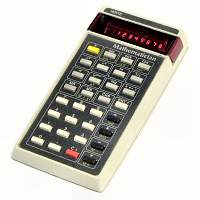 Novus Mathematician, Model 4510, S/N 179491
Novus Mathematician, Model 4510, S/N 179491
Functions: ASMD, scientific functions
Technology: MOS-LSI (National MM5760N)
Display: 8 digits, LED module
Dimensions: 75W x 150D x 32H, weight 170g.
Manufactured: National Semiconductor, USA, 1975
The Model 4510 "Mathematician" is one of a family of LED-display
calculators manufactured under the Novus brand by National
Semiconductor Corporation (NS) in the mid-1970s. (National was and
still is a major US manufacturer of analog and digital integrated
circuits).
The Mathematician provides trig, log, and power functions, and a
single memory register. The "mathematician" label possibly comes from
a function to accumulate squares for statistical calculations. Data
entry uses the postfix (reverse Polish) system, but the calculator
does not use scientific notation. Numbers larger than 8 figures result
in overflow, which lights all the zeroes and decimal points. Function
calculations are slow, with a busy display and significant errors in
the 7th (or sometimes even the 6th) figure. The calculator was
no match for the Hewlett-Packard 35, but it was only a fraction of
the price, and was still a hundred times more accurate than the
slide rule.
The circuitry of the Novus 4510 uses a MM5760N processor and a
DM8864 LED driver, with no other components. The calculator draws
20-65mA (600mW max) from a standard 9V battery. A power-saving mode
changes the display to all decimal points after about 30 seconds of
inactivity.
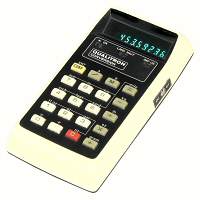 Qualitron Conversion Calculator, Model 1438, S/N 539155
Qualitron Conversion Calculator, Model 1438, S/N 539155
Functions: ASMD, conversion factors
Technology: MOS-LSI (Rockwell A4004PC)
Display: 8 digits, vacuum fluorescent module
Dimensions: 75W x 145D x 35H, weight 250g.
Manufactured: Qualitron, Taiwan, 1975
The Qualitron 1438 is a basic four-function calculator with a
range of pre-programmed conversion factors for distance, mass,
volume, and temperature. Two slider switches select land or nautical
miles, and US or Imperial volumes. There is provision to enter
a single user-defined conversion factor.
The conversion operations are very simple: enter the number, press
"CONV", select the present unit, then the required unit. For example,
to convert 1 pound to grams press 1 CONV lb gram
and read the result 453.59236.
The circuit board uses
a Rockwell A4004PC processor (no relation to the Intel 4004), an
Itron FG95A fluorescent display panel, and a "Best Choice" modular
power supply, with only about a dozen discrete components. Power is
supplied from four disposable AA batteries, or an external 6V adaptor.
The same machine with different nameplates was also sold as the
"Castle Model 1438 Conversion Calculator".
Castle 1438 conversion calculator.
Qualitron and Castle rear nameplates.
Qualitron 1438 circuit board.
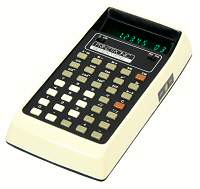 Prinztronic Scientific Calculator, Model SC4001M , S/N 928647
Prinztronic Scientific Calculator, Model SC4001M , S/N 928647
Functions: ASMD, scientific functions
Technology: MOS-LSI (GI CF-596)
Display: 8 digits, vacuum fluorescent module
Dimensions: 75W x 145D x 35H, weight 250g.
Manufactured: Made in Taiwan, 1975
Prinztronic was the house brand of a British company which sold
re-branded calculators from a variety of manufacturers. This Model
SC4001M scientific calculator is obviously from the same factory as
the Qualitron/Castle shown above.
The scientific functions include exponential notaion, trig
functions and their inverses in degrees or radians, natural logs,
square roots and reciprocals. There is a single memory register.
The calculator operates to 8 significant figures, but displays only
5+2 digits in scientific notation. The trig and log functions are
quite slow, and are only accurate to 5 figures. The
circuit board
is similar to the Qualitron above, but with a General Instruments
CF596 processor and a Futaba 9-ST-12 display module.
Prinztronic SC4001M circuit board.
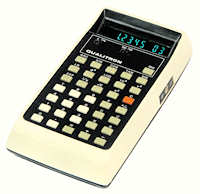 Qualitron Scientific Calculator, Model 1450, S/N 1001516
Qualitron Scientific Calculator, Model 1450, S/N 1001516
Functions: ASMD, scientific functions
Technology: MOS-LSI (Rockwell A6500CA)
Display: 8 digits, vacuum fluorescent module
Dimensions: 75W x 145D x 35H, weight 250g.
Manufactured: Qualitron, 1976
The Qualitron 1450 from 1976 appears to be a later and more
capable version of the Prinztronic machine above. The 5 memory keys
have been reduced to just Store and Recall, and replaced with base-10
logs, powers, and two levels of parentheses.
The
circuit board is similar to the two machines above, but with a
Rockwell A6500CA processor and a Futaba 9-ST-10 display module.
A ribbon cable has been added for the keyboard connection, but there
are still plenty of loose flying leads to the switches and power
connector. All three machines use the same "Best Choice 4055"
modular power supply.
Qualitron 1450 circuit board.
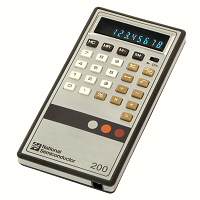 National Semiconductor, Model 200, S/N 0889-077
National Semiconductor, Model 200, S/N 0889-077
Functions: ASMD, percent, square root, 1 memory
Technology: MOS-LSI (National MM57134)
Display: 8 digits, vacuum fluorescent module
Dimensions: 70W x 135D x 15H, weight 160g.
Manufactured: Made in Taiwan for National Semiconductor, USA, 1976
The Model 200 is a basic four-function calculator with percent and
square root functions and a single memory register. The casing is only
15mm thick, but this increases to 20mm when enclosed in its
imitation-leather wallet. The calculator uses a fluorescent rather than
LED display, and carries National Semiconductor's own name rather than
the "Novus" brand of their consumer division.
The circuitry consists only of a MM57134 processor, and a modular
power supply to drive the Futaba 9-ST-10 display. The calculator
draws about 110-130mA (600mW max) from three AAA batteries or an
external AC adaptor.
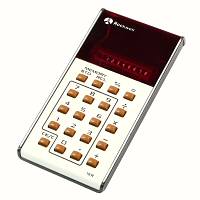 Rockwell LED Calculator, Model 18R, S/N 354123
Rockwell LED Calculator, Model 18R, S/N 354123
Functions: ASMD, percent, 1 memory
Technology: MOS-LSI (Rockwell B5000CC)
Display: 8 digits, NS LED module
Dimensions: 75W x 155D x 22H, weight 160g.
Manufactured: Assembled in Mexico for Rockwell International,
Anaheim, CA, 1976
The 18R is one of a family of LED-display calculators produced by
Rockwell under their own name in the mid-1970s, shortly before they
abandoned the calculator business. The machine illustrated was assembled
in Mexico using "US and foreign parts". Others are known to have been
assembled in England at the former Sumlock Anita factory.
The circuit board
uses a Rockwell B5000CC processor and an 8-digit LED display panel
from National Semiconductor. One digit position is sacrificed if a minus
sign is required - 0 minus 12345678 gives an error (all decimal points
lit) as there is nowhere to show the minus sign. The modular keyboard
plugs into the connectors around the right and bottom edges of the
circuit board. The calculator draws only 7 to 30mA (270mW max) from a
standard 9V battery mounted in the area above the display.
Rockwell 18R circuit board.
Original text and images Copyright © John Wolff 2005-13.
Last Updated: 20 January 2013
Back to: Home
Calculating Machines
 Adler Model EC-60, S/N 65050387
Adler Model EC-60, S/N 65050387









